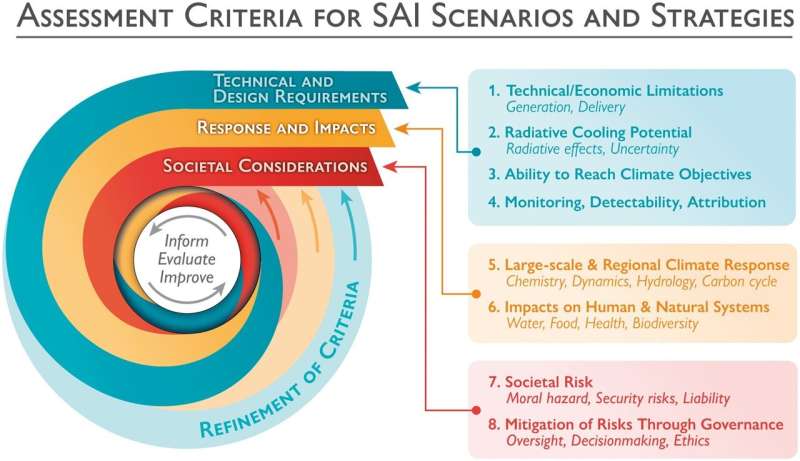
August 23, 2024 by David Hosansky, NCAR & UCAR
Collected at: https://phys.org/news/2024-08-scientists-guidelines-solar-geoengineering.html
Scientists for several years have studied the theoretical effectiveness of injecting sulfur dioxide into the stratosphere to reflect heat from the sun and offset Earth’s warming temperatures. But they also want to ensure that the solar geoengineering approaches being studied are evaluated for their technical feasibility, as well as their cooling potential and possible ecological and societal side effects.
To guide future work, an international team of scientists led by the U.S. National Science Foundation National Center for Atmospheric Research (NSF NCAR) has published a paper in Oxford Open Climate Change with specific recommendations for evaluating proposals to inject sulfur dioxide, which is known as stratospheric aerosol intervention (SAI).
The paper also suggests criteria for discontinuing those scenarios that are not feasible because of scientific, technical, or societal issues.
“The goal is to work toward an assessment that can be used to identify the most feasible and legitimate scenarios, based on both how much they reduce natural and societal risks as well as any unwanted side effects,” said NSF NCAR scientist Simone Tilmes, the lead author.
“If society were to ever consider implementing SAI, it is imperative that we provide the best possible scientific understanding to policy makers and the public.”
Mimicking volcanic eruptions
Once injected into the stratosphere, sulfur dioxide would form sunlight-reflecting sulfate aerosols. Previous studies, drawing on computer modeling and observations of large volcanic eruptions, have shown these aerosols would have a cooling effect similar to that of a major volcanic eruption.
The injections could continue to cool Earth for decades or even centuries, buying time until heat-trapping greenhouse gases in the atmosphere return to lower levels.
The previous research, however, has also emphasized the potential risks of SAI, such as changing the stratospheric ozone layer and altering global precipitation patterns.
Since such injections cannot perfectly offset the impacts of greenhouse gas emissions, Tilmes and her co-authors write that informed policy decisions require a comprehensive understanding of the benefits and risks of SAI. They emphasize the need for a research and governance structure, with fair representation from both the Global South and North, to oversee SAI research and technology developments.
“Research on various solar geoengineering methods has been going on for a few decades now, but there hasn’t been a formal assessment collating all the information in one place suitable for policy makers and the public,” said NOAA scientist Karen Rosenlof, a co-author of the new paper.
“It’s time for such an assessment to occur, covering the criteria described in this paper, and repeated on a regular basis.”
The paper proposes eight research criteria for assessing SAI developments. The criteria are:
- Technical and economic limitations
- Cooling potential
- Ability to meet climate objectives
- Infrastructure for monitoring, detection, and attribution
- Large-scale and regional climate response
- Impacts on human and natural systems
- Societal risks
- Mitigation of risks through governance
The paper recommends issuing assessment reports about SAI developments every few years with globally representative participation. The criteria can also be applicable to other solar radiation modification proposals, such as the brightening of marine clouds.
“The goal of these criteria is to promote optimal approaches from a climate perspective while carefully weighing the benefits and risks and making sure to include the perspectives of underrepresented groups and the Global South,” Tilmes said.
More information: Simone Tilmes et al, Research criteria towards an interdisciplinary Stratospheric Aerosol Intervention assessment, Oxford Open Climate Change (2024). DOI: 10.1093/oxfclm/kgae010

Leave a Reply